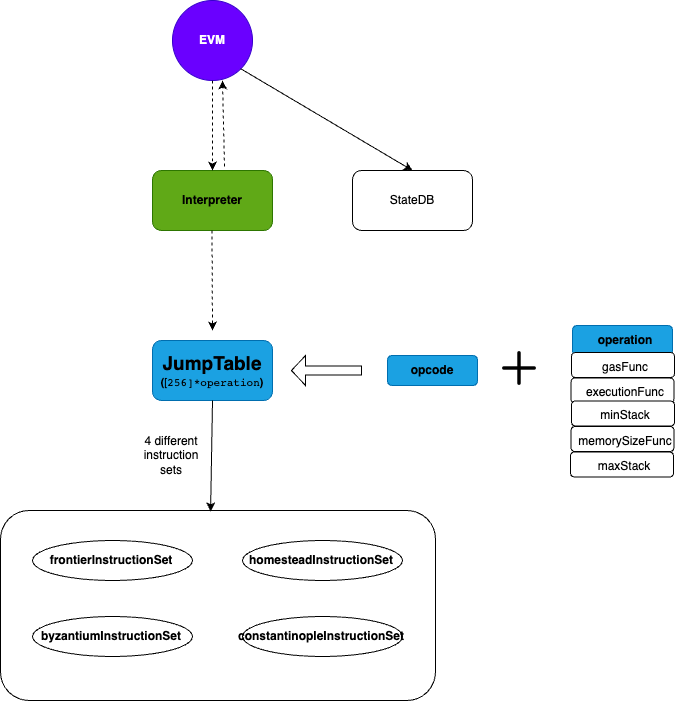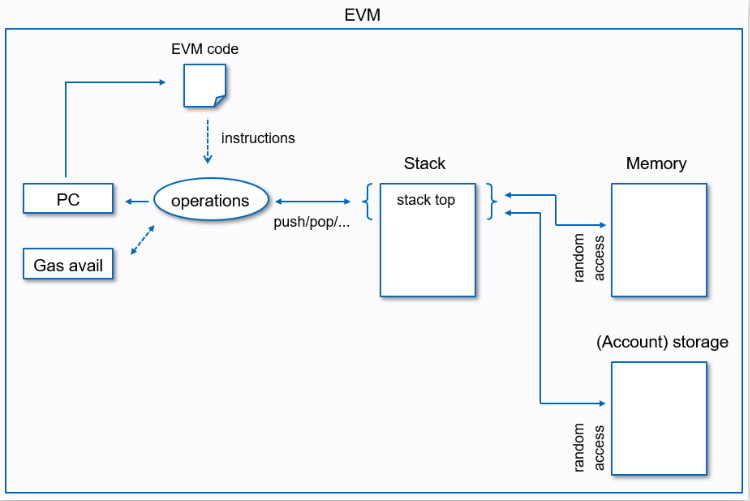overall
the code is under path core/vm
overview of the whole evm module 
the core is EVM struct (in evm.go), with main function in creating or call contract. a new EVM object is created every time when processing a transaction. inside the EVM struct, the main items are Interpreter, and StateDB (for state persistence). Interpreter loops through contract call instructions.Before each instruction is executed, some checks are performed to ensure sufficient gas and stack space. actual instruction execution code is recorded in JumpTable (256 sized array of operation)
depending on the version of Ethereum, JumpTable may point to four different instruction sets: constantinopleInstructionSet, byzantiumInstructionSet, homesteadInstructionSet, frontierInstructionSet. Most of the instructions of these four sets of instruction sets are the same, but as the version is updated, the new version supports more instruction sets than the old version.
evm
The EVM object is the most important object exported by the evm module, which represents an Ethereum virtual machine
creating evm
Every time a transaction is processed, an EVM is created to execute the transaction. This is reflected in the function ApplyTransaction (core/state_processor.go)
creating contract
If the to of the transaction is empty, it means that this transaction is to create a contract, so call EVM.Create to perform related functions
- CREATE
1
contractAddr = crypto.CreateAddress(caller.Address(), evm.StateDB.GetNonce(caller.Address()))
- CREATE2during create contract, an object
1
2codeAndHash := &codeAndHash{code: code}
contractAddr = crypto.CreateAddress2(caller.Address(), salt.Bytes32(), codeAndHash.Hash().Bytes())Contractis created. A Contract object contains and maintains the necessary information during the execution of the contract, such as the contract creator, the address of the contract itself, the remaining gas of the contract, the contract code and thejumpdestsrecord of the code.
then, it invokes below method to create contract
1 | ret, err := evm.interpreter.Run(contract, nil, false) |
If the operation is successful and the contract code does not exceed the length limit, call StateDB.SetCode to store the contract code in the contract account of the Ethereum state database. Of course, the storage needs to consume a certain amount of gas.
You may wonder why the stored contract code is the return code after the contract runs, not the data in the original transaction (ie Transaction.data.Payload). This is because when the contract source code is compiled into binary data, in addition to the original code of the contract, the compiler also inserts some codes to perform related functions. For creation, the compiler inserts code that executes the contract’s “constructor” (that is, the contract object’s constructor method). Therefore, when the binary compiled by the compiler is submitted to the Ethereum node to create a contract, the EVM executes this binary code, in fact, it mainly executes the constructor method of the contract, and then returns other codes of the contract, so there is a ret variable here Stored in the state database as the actual code of the contract
call contract
The EVM object has three methods to implement the call of the contract, they are:
- EVM. Call
- EVM. CallCode
- EVM. DelegateCall
- EVM.StaticCall
The basic contract call function implemented by EVM.Call is nothing special. The following three calling methods are the differences compared with EVM.Call. So here we only introduce the particularity of the last three calling methods
EVM.CallCode & EVM.DelegateCall
The existence of EVM.CallCode and EVM.DelegateCall is to realize the characteristics of the “library” of the contract. If the code written by solidity is to be called as a library, it must be deployed on the blockchain to obtain a fixed address like a normal contract. , other contracts can call the method provided by this “library contract”. But the contract also involves some unique attributes, such as the caller of the contract, contract address, the amount of ether it owns, etc. If we directly call the code of the “library contract”, these properties must be the properties of the “library contract” itself, but this may not be what we want
as an example
1 | A -> contractB - delegateCall -> libC |
EVM.DelegateCall sets the caller (msg.sender) of the “library contract” (libC) to A, rather than contractB; sets the address of the “library contract” (libC) to contractB.EVM.CallCode is similar to EVM.DelegateCall. the only difference is that EVM.CallCode only change the address of the “library contract” (libC) to contractB, without chanding the caller to A.EVM.StaticCall is similar to EVM.Call, the only difference is that EVM.StaticCall does not allow execution of instructions that modify permanently stored data
during contract call, it first check whether it is precompiled contract. some precompiled contracts are
- common.BytesToAddress([]byte{1}): &ecrecover{},
- common.BytesToAddress([]byte{2}): &sha256hash{},
- common.BytesToAddress([]byte{3}): &ripemd160hash{},
- common.BytesToAddress([]byte{4}): &dataCopy{},
EVMInterpreter
The interpreter object EVMInterpreter is used to interpret and execute specified contract instructions. However, note that the actual instruction interpretation and execution is not really completed by the interpreter object, but by the operation object JumpTable. The interpreter object is only responsible for parsing instruction codes one by one, and then obtains the corresponding operation object, and check objects such as the stack before calling the operation.execute function that actually executre the instruction. It can also be said that the interpreter object is only responsible for the scheduling of interpretation.
execution layout

intrinsic gas
The intrinsic gas for a transaction is the amount of gas that the transaction uses before any code runs. It is a constant transaction fee (currently 21000 gas) plus a fee for every byte of data supplied with the transaction (4 gas for a zero byte, 68 gas for non-zeros). These constants are all currently defined for geth in params/protocol_params.go.
gas cost
the gas cost of each instruction is stored in JumpTable.operation.dynamicGas or JumpTable.operation.constantGas. constantGas means the operation gas cost is a fixed constant. dynamicGas is a function which will return gas during runtime.
In fact, not only the interpretation and execution of the instruction itself consumes gas, but also consumes gas when using memory storage and StateDB permanent storage. For most instructions, the latter two are not used (memory & storage), but for some instructions (such as CODECOPY or SSTORE), their gasCost function will take memory and StateDB usage into account.
a method memoryGasCostis used to calculate the gas consumption of memory usage. only when the required space size exceeds the current space size, the excess part needs to consume gas.
JumpTable
jumptable is 256 sized array of operation
jump instruction
Among the instructions of the contract, there are two jump instructions (excluding CALL): JUMP and JUMPI. Their special feature is that the first instruction of the target address after the jump must be JUMPDEST
1 | func opJump(pc *uint64, interpreter *EVMInterpreter, contract *Contract, memory *Memory, stack *Stack) ([]byte, error) { |
A function interprets and executes the JUMP instruction. The code first fetches a value from the stack as the jump destination. This value is actually an offset relative to field 0 of the contract code. Then the code will call Contract.validJumpdest to determine whether the first instruction of this destination is JUMPDEST, if it is not, an error will occur.
To judge whether the first instruction of the destination is JUMPDEST, two points must be guaranteed: first, its value is the value of the opcode of the JUMPDEST instruction; second, it is an instruction, not ordinary data.
Let’s introduce how Contract.validJumpdest works. In addition to comparing opcode (this is very simple), Contract will also create a bit vector object (ie bitvec, bit vector). This object will analyze the contract instructions from the beginning to the end. If the byte at a certain offset of the contract belongs to ordinary data, the “bit” corresponding to the offset value in bitvec is set to 1, and if it is an instruction, it is set to 0. In Contract.validJumpdest, it is judged whether this is a normal instruction by checking whether the “bit” of the offset value of the jump destination in this bit vector object is 0